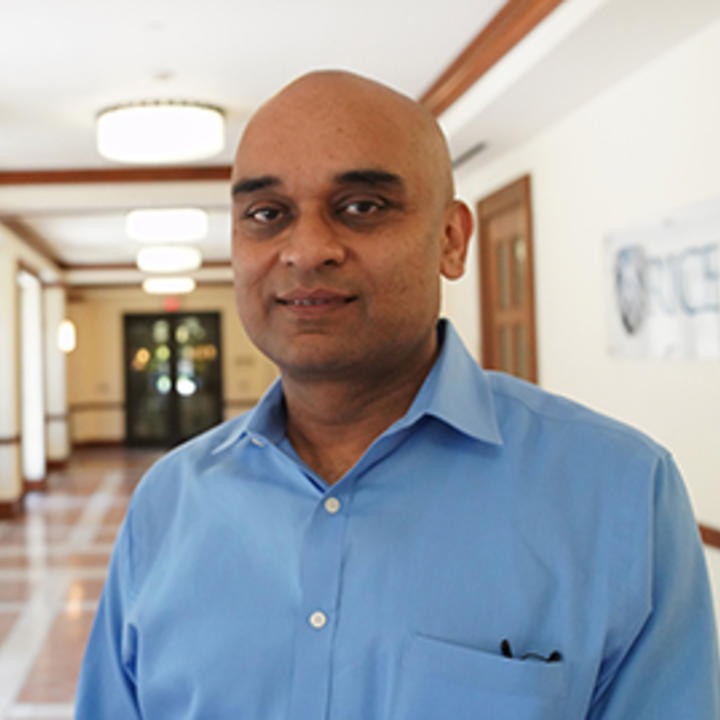Ovation Inflation
How do you know it's time to jump to your feet?


By Clifford Pugh
How Do You Know It's Time To Jump To Your Feet?
The Alley Theatre's world premiere of Cleo features a great story—the sizzling affair between Elizabeth Taylor and Richard Burton on the set of the 1963 movie Cleopatra in Rome—along with sumptuous staging and stellar acting.
But is it worth a standing ovation?
The audience on opening night certainly thought so. No sooner had the last word of the play been spoken when several patrons jumped to their feet. They were soon joined by more and more theatergoers, until the only ones who remained sitting were my husband and me. We applauded enthusiastically but didn’t feel the play merited such over-the-top praise.
Call me old-fashioned, but I believe a standing ovation should be a precious thing saved only for that rare occasion where something is so extraordinary and superlative that you can’t help but want to salute it in a special way.
I’m obviously in the minority.
A few nights later, we were at Stages Repertory Theatre, where Sally Edmundson sparkled in a one-woman show about former Texas Gov. Ann Richards. She did a great job and, again, the audience erupted in a standing ovation at the end. This time we stood up, too, not because we thought Edmundson’s work merited that extra praise but because I was sitting next to her husband and was too embarrassed to remain seated in his presence.
While Houston audiences are standing-ovation crazy, it’s not just a Texas phenomenon. On the daily television gabfest The View, the audience always jumps to its feet as soon as Whoopi Goldberg, Joy Behar, and the other panelists walk onstage. When former FBI director James Comey recently was a guest to tout his new book, the audience leapt to its feet again.
Comedian Bill Maher also regularly draws a standing O on his HBO talk show, but even he was surprised on a recent show when the audience stood for Stormy Daniel’s attorney, Michael Avenatti.
“I want this recorded: A lawyer got a standing ovation,” Maher cracked.
What’s the reason for ovation inflation?
Rice Business assistant clinical professor of marketing Constance Elise Porter surmises that it represents our desire to express an opinion on everything we experience.
“We are a cheerleading type of society, so when we are excited and happy about things, we want to like it, whether it’s online or with a standing ovation. We believe in expressing opinions—good and bad,” she says.
There’s also the peer pressure to be part of the crowd, she suggests. “You don’t want to deviate from the norm. Whether you strongly approve of it or or not, you’re going to stand up more than likely when everyone else does, unless you disapprove of it completely.
“There’s a herding theory, and this is a part of it,” Porter adds. “This can be positive, or it can be negative. Often, when juveniles commit offenses in groups, it’s because they wanted to be a part of the crowd, in the moment, rather than because they held a strong belief that the action was appropriate.”
I’m not about to suggest that giving a standing ovation is akin to criminal behavior, but it could be a desire to confirm our good judgment. With ticket prices continually escalating, we want to believe we got our money’s worth. You can bet that audiences at Hamilton, now at the Hobby Center for the Performing Arts, will rise for an ovation, given the money they spent to attend.
A few years back, New York Times theater critic Ben Brantley made the case for “the return of the sitting ovation." Because we have really reached the point at which a "standing ovation doesn’t mean a thing,” he wrote.
Alas, his suggestion didn’t take hold.
He also pointed out that, according to legend, when Arthur Miller’s Death of a Salesman opened on Broadway in 1949, the audience was so moved that it sat in shocked silence at the end of the play before the applause began.
Brantley doesn’t say, but I’m guessing a standing ovation occurred that night. And it was well-deserved.
I might have even joined in.
This article first appeared in Houstonia as "Please Stop Giving Absolutely Everything a Standing Ovation."
Never Miss A Story
Keep Exploring
Not Throwing Away My Shot
How data from two-round election systems can help candidates target their campaigns.


Based on research by Wagner Kamakura
How Data From Two-Round Election Systems Can Help Candidates Target Their Campaigns
- In two-phase elections, voter-choice models can help politicians strategize for an election’s final round.
- Political consultants and candidates in these systems should scrutinize data on the voting behavior observed in the first round of elections.
- First-round voter data can help candidates better deploy their campaign resources for the runoff.
Not all democracies are created equal. In most democratic countries, dozens of political candidates tussle for government posts at election time. But when it’s time to choose a head of state, the majority of elections are a two-round process: a main election with many contenders, followed by a runoff between the first-round winner and runner-up. Of the 109 countries that hold elections for head of state, 71 have a two-round election system.
Yet scholars have spent little time studying these elections, Rice Business professor Wagner A. Kamakura discovered. Unlike in U.S.-style elections, where polls taken moments before or after an individual vote can only reflect intentions, which don’t always correspond with what someone really does, two-round elections offer a chance to analyze actual voting data. The value of these numbers is more than academic: Using data gleaned from the first round of voting, Kamakura shows how a candidate can shape strategy in a runoff.
To learn more about the two-round election process, Kamakura studied voter-choice models based on the past four presidential elections in Brazil, the most populous country to have a two-tier system. He focused on four major lines of inquiry that could offer practical insight:
- Studying elections in which second-round candidates held respectively strong and weak positions.
- Determining the impact of swing voters, those who supported eliminated candidates, during a runoff.
- Identifying the best investments for the runoff campaign in order to sway swing voters.
- Combining first round results with other polling data to create simulations predicting the final outcome, conditional on the last polling results.
Opinion polls, Kamakura found, are potentially misleading, because voters don’t always say what they’ll do or do what they say. Because of their limited sampling numbers, pollsters can’t gather detailed information at the regional or district levels, even though, as is often said, “all politics is local.”
Data pulled from Brazil’s electoral first-rounds were more thorough. During the 2014 presidential election, Kamakura writes, Brazilians chose from 11 candidates during the first round of voting. Some variables remained unpredictable in the final contest, such as the effect of attacks by an eliminated candidate against a surviving candidate, or whether eliminated candidates would form alliances with one of the runoff’s still-viable contenders.
Nevertheless, Kamakura found, in two-election systems, the final campaigns could rely more on gathered in each electoral district than they could on the mere intentions reflected in opinion polls. Knowing what voters actually did in a first round — that is, their real behavior — rather than just what they told a pollster they were going to do, was crucial. In Brazil, these true voter data were available for each of the country’s 6,266 districts, providing a mother lode of intelligence that helped campaigns deploy their resources with regionally-focused precision.
However, this wealth of data comes with a strong caveat — actual voting data is not available for individual voters, but only at the district level to protect voters’ privacy. Estimating individual political preferences using the district-level data requires a sophisticated voter-choice model, which is Kamakura’s main contribution. This attempt to draw individual-level inferences from aggregate data is a relatively new field known as symbolic data analysis.
Beyond providing a baseline of reliable data, Kamakura writes, studying voter choice can produce micro (that is, district)-level policy simulations for an election’s second round. While voter-intention polls and opinion surveys may offer useful insights at the national level, Kamakura argues, candidates in countries with a two-round election system need to study the local findings to better target their campaigns. Politicians and campaign managers can spend a fortune on opinion polls, which, as Kamakura points out, are well known to be biased. The risk is that they may get distracted by voters’ stated intentions and overlook their actual, true voting behavior at the micro-level.
Using information from the initial election, he writes, candidates and their advisors need to study how voters who supported an eliminated candidate now perceive the surviving candidates. Those swing voters, Kamakura notes, will determine the final outcome — it’s unlikely that a first-round supporter of one of the surviving candidates will switch to the other on the final vote, although some might do so for strategic reasons.
No one can really get into a voter’s mind. What Kamakura’s research does, however, is show that in two-stage elections, actual voting data from the first stage can yield important district-level details, something that is not technically and economically feasible with voting-intention polls. Candidates lucky enough to land in a runoff can — and should — use this data to quickly reshape their second-round campaigns for a better shot at the top.
Wagner A. Kamakura is the Jesse H. Jones Professor of Marketing at Jones Graduate School of Business at Rice University.
To learn more, please see: Kamakura, W. A. (2016). Using voter-choice modeling to plan the final campaign in runoff elections. Revista de Administração Conteporânea, 20(6), 753-776.
Never Miss A Story
You May Also Like
Keep Exploring
The Data Security Paradox
Outsourcing a security increase can make company data more vulnerable, rather than less.


Based on research by Sharad Borle and Ravi Sen
Telling the truth and investing in proper security measures may be costly — but they’re a bargain compared to the long-term effects of cyber theft.
Key findings:
- Investment in certain types of security measures actually corresponds with a higher risk of data theft, both within government and within industry.
- Data disclosure laws can have an unintended consequence: putting firm information at higher risk.
- In some industries, stricter laws requiring transparency in data breach cases are linked to less data theft.
When hackers forged an assault on Dallas-based department store Neiman Marcus in 2013, they put at risk 1.1 million credit and debit cards. The clandestinely inserted malware was the same deployed earlier by cyber thieves who accessed sensitive information in Target stores, exposing the data of about 110 million customers. Neiman Marcus, though, did not recognize the breach for several months. When the damage was finally revealed, the department store offered some 2,400 shoppers affected by the fraud a free year of credit monitoring.
While only about a quarter of credit card transactions occur in the United States, almost half — 47 percent — of global card fraud takes place in this country. And these breaches are on the rise. Why is data at such high risk? Rice Business Professor Sharad Borle examined the factors influencing data breaches in both government and industry. His findings provide useful practical guidance for firms fighting to ward off cyber thieves. Borle’s insights research are of special use to IT risk assessment experts.
Rather surprisingly, Borle found that investing in information technology security corresponds to higher risk of data theft in both government and industry. This directly contradicts a common criminology theory, the opportunity theory, which posits that criminals are drawn to easy targets.
One explanation for the counterintuitive findings may be that firms are investing in IT security controls inefficiently, installing firewalls and anti-virus software at the expense of administrative and even physical controls. According to one survey, 45 percent of IT security budgets go to software and hardware. The problem is that these aren’t necessarily more secure than the underlying systems they are meant to protect. In fact, several security software systems may have vulnerabilities that could increase the opportunity for data thieves.
The costs for everyone affected are vast. In recent years, major data breaches have compromised sensitive, protected or confidential data including health or personal information, trade secrets, intellectual property or financial data. Every time one of these breaches occurs, studies show, the affected company’s stock prices drop about five percent.
To understand why data breaches are so common in this country, Borle turned to the poetically named “institutional anomie” theory. Focusing on the social causes of crime, this theory argues that advanced societies assign higher-level priority to economic institutions such as markets than they do to legal and family structures. The result is a higher likelihood of crime. The market economy’s promotion of a calculating, materialistic attitude towards social relationships, the theory contends, directly leads to more criminal activity.
Analyzing different types of data breach incidents, Borle used intervals between past breaches along with various explanatory factors to mathematically predict the firm’s next breach, thus assessing the risk of a future breach for a firm. He also investigated the role of disclosure laws, which force organizations to act transparently and improve their data security controls in preventing these crimes.
Borle found that in certain industries, strict disclosure laws indeed correlate with less data crime. These industries included financial, educational and medical fields. But the laws didn’t not necessarily benefit consumers, he found. This is because companies may outsource protection services, which can actually put data at even greater risk. Amazingly, some security software systems have vulnerabilities that actually increase the opportunity for data thieves. The lessons?
Transparency requirements — though costly for the firm that must admit a breach — significantly reduce risk certain industries overall. But outsourcing security can make a company’s data more vulnerable, rather than less. On the internet, there are no secrets — except for those firms that sit on information about colossal security lapses long enough to endanger other companies and consumers. Telling the truth, and investing in proper security measures may both be costly — but they’re a bargain compared to the long-term effects of cyber thieves rampaging unchecked.
Sen, R. & Borle, S. (2015). Estimating the Contextual Risk of Data Breach, an Empirical Approach. Journal of Management Information Systems, 30.2: 314-341.
Never Miss A Story
You May Also Like
Keep Exploring
Data. Mine.
Americans have been feeling very protective of our data lately. But what is it exactly that we’re trying to protect?


By Jennifer (Jennie) Latson
Americans Are Very Concerned About Data
When Facebook CEO Mark Zuckerberg testified before a Senate committee in 2018, he was supposed to clarify how his social media site uses — and maybe abuses — the personal data of its 2 billion monthly users.
But what the hearing revealed instead, as many analysts have pointed out, was that few senators seem to have a firm grasp on what Facebook does, how the internet works, or what they mean by the word “data.”
Take this exchange between Zuckerberg and Senator Deb Fischer, R-Nebraska:
FISCHER: So how many data categories do you store, does Facebook store, on the categories that you collect?
ZUCKERBERG: Senator, can you clarify what you mean by “data categories”?
FISCHER: Well, there's — there's some past reports that have been out there that indicate that it — that Facebook collects about 96 data categories for those 2 billion active users. That's 192 billion data points that are being generated, I think, at any time from consumers globally. So how many do — does Facebook store out of that? Do you store any?
ZUCKERBERG: Senator, I'm not actually sure what that is referring to.
The discussion went on awkwardly for a while. Ultimately, however, Fischer revealed that her chief concern was not the number of data points Facebook stored, but something more primal. “Is Facebook — is Facebook being safe?” she asked.
Senators aren’t the only Americans who have a generalized dread about bad things happening to our data — but no clear idea what exactly we mean by “data,” or why it’s so important to protect.
Many of us are worried by revelations that the consulting company Cambridge Analytica, hired by the Trump campaign during the 2016 election, accessed the private data of 87 million Facebook users and used it to create detailed personality profiles and highly specific marketing pitches.
This is, of course, far from the first widespread data breach we’ve weathered. The 2017 Equifax breach also compromised the personal data of millions of Americans, including our Social Security numbers, birth dates, and credit card numbers. But the data Facebook shared is far more personal, and that may be why the breach feels like even more of a violation. Cambridge Analytica is unlikely to open a line of credit in our names, but it’s somehow creepier to think about all the things they’ve found out about us: which hotel we stayed at on vacation, when we potty-trained our kid, what Disney princess we would be.
What makes it creepy is that they can, and did, use this intimate information in an attempt to manipulate how we think and act. That’s what most of us are really talking about when we talk about protecting personal data: the fear that people will use knowledge of our habits and preferences to serve their own purposes.
Facebook wasn’t the first to use (or allow others to use) personal information to influence our behavior. As long as “data” has existed, it’s been scrutinized by people who want to sell us products, get our votes, or change our opinions.
Nearly a century ago, advertisers were already working to harness the power of behavioral psychology to develop “subliminal advertising” that would motivate us to buy what they were selling without realizing we’d been influenced, Vanderbilt history professor Sarah Igo explains. “Those probes into consumers’ personalities and desires foreshadowed Cambridge Analytica’s pitch to commercial and political clients – using data, as its website proudly proclaims, ‘to change audience behavior,’ ” says Igo, the author of a forthcoming book, “The Known Citizen: A History of Privacy in Modern America.”
Many people recoiled then, as they’re doing now. Especially in the U.S., where independence and self-reliance are highly prized, the possibility that our psyches might be shaped by outside forces — without our awareness or consent — is extremely threatening.
“We have a lot invested in the idea that we’re autonomous individuals, that we’re in charge of ourselves,” Igo explains. “The idea that there’s this psychological probing going on all the time threatens that image of who we are at some deep level.”
But there are benefits to sharing our personal data, and that’s why so many of us do — not just on Facebook, but with Google, Apple, Amazon, Netflix, Fitbit, E-ZPass and countless others.
“We aren’t giving away our personal details only on Facebook. We are giving away our personal details every time we go online for any purpose,” says Utpal Dholakia, a marketing professor at Rice University’s Jones Graduate School of Business. “Coming to Facebook, we all have some basic social needs, such as to be acknowledged, respected, valued, praised, etc. — which is why we give away our information. I will give just one example: our birthday. Most people like to be greeted on their birthday, so they post their real birth date. The risks are obvious. The smartest thing to do is to share minimum amount of personal information on social media.”
Some people, however, argue that the benefits outweigh the risks, and that we should embrace the convenience and efficiency of a fully-connected, privacy-free future.
“The bottom line is that we can’t say, ‘I want my technology personalized to me, but I don’t want companies to know too much about me,’” argues Ben LeDonni, CEO of the digital strategy agency CreativeMMS. “The technology needs to know as much as it can about you to help personalize your experience and make it richer, better and easier for us all.”
That’s a hard sell for those of us who want to retain some control over how our data is used and who’s using it. And while we recognized that Facebook was using the intel it gathered for the mildly disturbing purpose of showing us targeted ads, few of us realized just how much was actually at stake.
“We all knew that Facebook was harvesting our data, but we were seduced by its free ‘gifts,’ and unaware of the significant cumulative value of the totality of our privacy exposures,” said Moshe Vardi, director of the Ken Kennedy Institute for Information Technology at Rice. “The Cambridge Analytica affair revealed two things. First, the cumulative value of our minor exposures is quite significant, perhaps enough to tilt the result of the 2016 election. Second: It was not just Facebook that was collecting our data. It was also done by third parties we have never heard about, and on a rather massive scale.”
The fact that this time our data was used for political propaganda, and not just the commercial propaganda we’ve come to expect, is part of what makes this scandal so troubling. But political propaganda has been around forever, too. Cambridge Analytica’s tactics aren’t so different from the “push polls” pioneered by the Nixon campaign, in which pollsters used loaded questions to push people toward a particular candidate, Igo points out.
“There’s a continuum here — it’s not brand new, by any means. The techniques are just more sophisticated and less visible, and there’s the added layer of outside parties tampering with the very information that people are getting in the first place,” she says.
And while in the past you’d have to choose to take part in a poll or a focus group, social media has created a constant stream of opportunities for us to provide our personal information to propagandists without thinking twice about it. We don’t even have to post it, since so much of our online activity is being tracked. The Chronicle’s Dwight Silverman calls this information “a kind of ‘dark matter’ data.”
“Facebook uses both user posts and this dark-matter info to build a set of interests associated with you,” he writes. “If you routinely click on country music videos … the site may add ‘country music’ to your list of interests. If you share a lot of posts from progressive political pages, it may tag you as a liberal.”
So how can we reclaim our personal details? An obvious step would be to stop taking online quizzes. The source of the Cambridge Analytica leak was, after all, a personality quiz app called “This Is Your Digital Life.”
But are we idiots if we downloaded the app? No, says Igo. Technology is changing too quickly for the average social media user to be expected to recognize all the risks at any given moment.
“That’s an impossible task,” she says. “My point is not that people should take on that burden themselves, but that, as citizens, we should have some say on how data is used in our country and beyond. It has to be a political solution, not a behavioral solution.”
Whether or not we should change our online behaviors, we’re unlikely to, says Dholakia.
“A much more serious milestone was the data breach at Target, when the financial information of 41 million customers was stolen,” he says. “That didn't change consumer behavior in any significant way, so I don't think this will.”
But a political solution could be on the horizon. The European Union adopted a data protection law that will go into effect next month — and the U.S. Congress is discussing ways to follow suit. Sooner or later, we will need some ground rules governing the use of personal data, Vardi argues.
“We keep generating data points, and there are other third parties out there that are hungry for data,” he says. “So the discussion is very much alive.”
Jennifer Latson is a staff writer and editor at Rice University's Jones Graduate School of Business and the author of The Boy Who Loved Too Much.
This article originally ran in the Houston Chronicle’s Gray Matters: https://www.houstonchronicle.com/local/gray-matters/article/facebook-privacy-data-protection-debate-12842032.ph
Never Miss A Story
Keep Exploring
Back To Basics
As the list of customer metrics grow, which ones indicates financial growth, and which are just a fad?


By Vikas Mittal
As The List Of Customer Metrics Grow, Which Ones Indicates Financial Growth, And Which Are Just A Fad?
Recently, one of my academic colleagues said: “Customer satisfaction is so yesterday. There are so many new metrics like customer engagement. It’s high time we abandon customer satisfaction.” That same afternoon, I was in a meeting with the vice president of strategy for an engineering company with approximately $10 billion in revenue, who said, “Our board wants to increase sales, margins and stock price, so they need to see improvements in promoter scores. That’s what they want, and that’s what we will deliver.”
Both conversations got me thinking about the value of different customer metrics. Executives are confronted with a variety of metrics, such as customer satisfaction, complaints, recommendations, repurchase and net promoter scores. Which metric should they adopt? The market for ideas is efficient and evolving. On the one hand, we should embrace the notion that new customer metrics keep surfacing. On the other hand, executives need an evidence-based approach to separate the wheat from the chaff.
To select the right customer metric, executives need to consider two factors. First, they should focus on a customer metric that is an enduring practice, not a fad. Rather than over-simplifying, a customer metric should mirror the complexity of a customer-centric firm, the needs of its customer base and the ability to implement specific customer-based initiatives. An enduring customer metric will not be a magic bullet. Second, an enduring metric should show evidence for improving sales, margins, cash flow and market share. By adopting and improving scores on the customer metric, executives should show demonstrable improvement in sales, margins, market share and other financial metrics.
Customer Metrics that Matter for Financial Outcomes
At the crux of measuring customer metrics—whether net promoter scores, engagement or satisfaction—is the belief that improving these scores will improve financial outcomes for a firm. How true is this belief, and is it supported by evidence? If the evidence does not support a link between a customer metric and financial outcomes, what good is the metric as a strategic planning tool?
A 2006 study of 80 different companies over six years (1994-2000) sought to answer this question. The authors of the resultant paper, “The Value of Different Customer Satisfaction and Loyalty Metrics in Predicting Business Performance,” statistically compared the ability of several survey-based customer metrics to predict key financial outcomes. They compared five customer metrics: average customer satisfaction, customer complaints, repurchase intentions, net promoter score and word-of-mouth recommendations. They wanted to answer one question: Do any of these customer metrics statistically predict sales growth, gross margin, net operating cash flow, market share and shareholder return?
Before you read any further, do a thought experiment to test if you have a bias. Which one did you pick as being best able to predict these financial outcomes? The table below shows the results.
Only three metrics—customer satisfaction, repurchase intention and complaints—predict sales growth and gross margins. When it comes to operating cash flow and shareholder return, only customer satisfaction has any predictive ability.
The only customer metric that predicts and improves all five financial outcomes is customer satisfaction. The next-best metric is repurchase intention, predicting three of the five outcomes. Whether a board wants to grow sales, improve gross margins, increase cash flow, expand margins or create shareholder value, the one customer metric to grow is customer satisfaction.
Net promoter scores were related to zero out of five financial outcomes. Another study in the Journal of Marketing, “A Longitudinal Examination of Net Promoter and Firm Revenue Growth,” examined results from 21 companies and more than 15,000 interviews to find the same conclusion. “Managers have adopted the net promoter metric for tracking growth on the basis of the belief that solid science underpins the findings and that it is superior to other metrics. However, our research suggests that such presumptions are erroneous,” the authors of that study write.
Fad and Enduring Practices
Management fads are simple, prescriptive, falsely encouraging and lack scientific evidence for their efficacy, yet most followers believe they work. Net promoter scores are not backed by any credible evidence of financial predictive ability but have caught on because they seem simple (one item measures it all), prescriptive (you can compute the promoter score for every customer segment) and falsely encouraging (increasing promoter score is believed to increase sales, revenue, share and profits).
In contrast, customer satisfaction is backed by credible evidence and provides a well-established framework for customer-based execution and strategy. To pull it off, an executive must work with trained statisticians to identify key drivers of satisfaction, understand their relative weights, derive the link between customer satisfaction and financial outcomes, and then make investments to improve key attributes. None of this is simple, nor does it provide false encouragement that satisfaction is the cure-all remedy. Research on customer satisfaction shows that very high satisfaction can be costly for companies, and satisfaction has differential effectiveness for different outcomes.
Satisfaction Mismatch
A 2017 study published in the Journal of the Academy of Marketing Science, “Do Managers Know What Their Customers Think and Why?,” examined 70,000 customers and 1,068 managers from 97 different companies to determine if manager perceptions of customer satisfaction are aligned with customer perceptions. The study showed three results: First, managers overestimate the extent to which customers are satisfied and loyal. Second, managers underestimate the extent to which customer satisfaction drives complaints and loyalty by almost 40%. Third, when manager perceptions are misaligned with customer perceptions, customer satisfaction suffers.
For customer-based strategy, these findings mean that not only are most customers less satisfied than managers believe, but most managers underestimate the loyalty benefits of satisfying customers. This leads to further declines in customer satisfaction. Disheartened, managers chase fads like net promoter scores, which lead to further declines in customer satisfaction. Caught in a vicious trap of chasing fads, executives let customer satisfaction, a proven metric, suffer and negatively impact customers and investors.
Now What: Back to Basics
Rather than chasing fads, executives will benefit from going back to basics that help them measure customer needs. To fully incorporate customer needs in the planning process, executives should use a holistic approach that provides concrete guidance for customer-based execution and strategy. Such an approach—measuring customer satisfaction and its components—paints a realistic portrait of customer needs. For senior executives, it provides a roadmap for financial management by predicting sales, margins, cash flow, market share and stock market value. Thus, customer satisfaction can serve as the one metric that advances the cause of customers and shareholders in unison.
When executives chase fads instead of staying focused on customer satisfaction, customers lose with lower satisfaction, investors lose with lower financial performance, and the firm loses to competitors. To avoid this trap, executives need to remind themselves that their main objective is to satisfy customers and create value for investors, not chase fads.
Vikas Mittal is the J. Hugh Liedtke Professor of Marketing and Management at the Jones Graduate School of Business at Rice Univeristy.
This article first appeared American Marketing Association's Marketing News as Which Customer Metric Best Predicts Financial Performance?
Never Miss A Story
You May Also Like
Keep Exploring
Long Season
The shale industry is in the 3rd inning, but many factors will determine how the game plays out.


By William M. Arnold
The Shale Industry Is In The 3rd Inning, But Many Factors Will Determine How The Game Plays Out
Recent media attention questions the future of shale oil production in the U.S. Will capital discipline put a brake on growth or will domestic production rise to the point of undermining prices again? As so often in business, it’s the investors who will make the call.
In the first inning of the shale boom, from 2009 to 2014, the mostly small players raced to lock up prospects by leasing land and drilling — but not necessarily completing — wells. These are the “DUCs” (drilled but uncompleted) described in many articles.
It was a land grab of epic proportions, the energy equivalent of “shooting the moon” in a card game of hearts. But even before the oil price collapse in late 2014, that strategy caused problems for overextended companies, such as Oklahoma’s Chesapeake Energy Corp.
In the second inning, from early 2015 to mid-2017, bravado turned into bankruptcy for hundreds of players and there was incessant pressure on suppliers to reduce costs. But the collapse of market prices also provided the focus that was missing in the early years.
Companies had to concentrate on their best prospects and exert cost discipline in all operations. Good operators found, sometimes to their surprise, that they could operate profitably with prices in the range of $40 to $50.
We are in the third inning now, with apparent oil price stability of $60 to $65 in the U.S. and topping $70 for North Sea-based Brent. Investors won’t tolerate backsliding to the practices of the first inning and will demand that producers, well, produce. They can complete those DUCs and use the cash flow to finance further activity.
Performance in future innings will depend on geology, technology, operational efficiency, OPEC and capital availability.
Mother Nature was fickle in how she placed resources. To deal with that, companies continuously develop and apply technology to compensate. Horizontal drilling and fracking enabled production from rock-hard, linear formations rather than the “straw in the glass of Coke” that many people understand oil production to be.
While there are concerns about rising costs from equipment and service suppliers, the industry continues to innovate with more wells on a single platform and increasingly apply sophisticated data analytics.
They have even found they don’t need to import trainloads of fracking sand from Michigan; there is plenty of sand in West Texas that meets specs.
Saudi Arabia has made disproportionately large cuts to its production to balance markets and persuade even non-OPEC countries such as Russia to participate. This is in contrast to the end of the first inning, when OPEC thought a price collapse would kill off the shale revolution in the U.S.
For more than a year, Saudi Aramco has been in discussions for an initial public offering (IPO) that reportedly might cover about 5 percent of its reserves, for about $100 billion. That has been postponed until 2019.
Saudi has a stake in keeping prices high to get the best valuation for that IPO. The question is the extent Saudi Arabia and OPEC are willing to be the swing producers to accommodate unprecedented levels of U.S. production.
Capital availability is the final element, and it covers a lot of actors. Traditionally, investors bought shares in the majors because of their long-term record, potential upside from exploration and portfolio balancing from the midstream (pipelines) and downstream (refining and marketing).
This model came under attack in 2011 when activist investors persuaded ConocoPhillips and Marathon to break up into separate companies focused on either exploration or refining. Investors increasingly want to develop their own risk portfolios, not have company management do it for them.
The shale play brought in new investors who wanted to stake qualified management teams who were unencumbered by legacy assets. They sought returns that were closer to 20 percent than the more modest returns of the majors.
What we now have is a wider range of investors with risk profiles along a spectrum. Some want steady income, stock buybacks and reliable dividends. Others want even less volatility and may settle for utility returns, which they see as possible as domestic oil production takes on manufacturing characteristics. Still others want to support higher-risk return investments, whether in West Texas or East Africa.
The reality is that market conditions, attitudes of investors and operational performance will determine U.S. oil production in the next few innings. OPEC can accept this or make a “lose-lose” decision; again.
William M. Arnold was a professor in the practice of energy management at the Jones Graduate School of Business at Rice University.
This article first appeared on The Hill as Shale Boom Is In The 3rd Inning; Investors To Decide How The Game Plays Out.
Never Miss A Story
You May Also Like
Keep Exploring
School Spirit
What for-profit businesses can teach nonprofits about customer satisfaction.


By Vikas Mittal
What For-Profit Business Can Teach Nonprofits About Customer Satisfaction
Nonprofit organizations differentiate themselves from traditional businesses by their profit focus. Of course, businesses are customer-focused — they exist to make money from their customers. Nonprofits believe they exist to fulfill a mission and vision and to meet every stakeholder’s needs. All too often fulfilling the mission becomes a self-fulfilling prophecy that distracts nonprofits from meeting the needs of their customers. Confusing myriad stakeholders, such as employees and suppliers, with customers, nonprofits can become internally focused, dedicating themselves to costly initiatives that consume organizational resources but do not improve customer satisfaction.
Nowhere is this more evident than in one of the largest nonprofit enterprises worldwide, the U.S. K-12 public school system. The superintendent of an underperforming school district told me the district’s strategy was based on key initiatives, such as “data-driven decision-making” and “aligning cultural values.” The former initiative led millions of dollars to be dedicated to data management systems, and the latter led to extensive training and countless culture-building exercises. Proud of its investments, the district leadership remained puzzled as to why its customers — students and parents — were leaving the district for private, charter and home-schooling options.
We conducted a district-wide study to measure the state of parent satisfaction in the district. It revealed low parent satisfaction driven by low academic standards, perceptions of unsafe schools and perceived lack of parent engagement. When asked about the disconnect, the superintendent responded, “Of course we care about parents. That is why we are completely focused on data-driven decision-making and cultural alignment. These initiatives reinforce our mission to become the best school district possible.”
What’s causing the disconnect? The school district started with its mission, not with the needs of its customers. This systematically subordinated the customers’ needs to the mission, values and vision of internal stakeholders — teachers, staff and administrators. Though all the stakeholders claimed to care about customers, they were really driven by an inward-looking approach. As a result, the district invested more in internal initiatives that did little to satisfy customer needs. Dissatisfied, the customers migrated to other providers. This migration only dampened the morale among front-line employees, with the district declaring an intensifying need for cultural alignment. The downward spiral of lowered customer satisfaction, followed by the launch of internally focused initiatives, continued unabated, even as a growing number of students and parents sought to explore other options.
The way out of this spiral involves embracing lessons learned from successful businesses.
Define Your Customer, Unambiguously
Strong organizations are customer-focused. They do not confuse their customers with other stakeholders — even as they recognize the importance of other stakeholders in satisfying customer needs. While it is fashionable to lump all stakeholders in the same bucket and treat them as customers, it is strategically dysfunctional to equate customers with other stakeholders.
Consider a nonprofit such as a hospital. Nurses, physicians, pharmacists, administrators and suppliers are a hospital’s stakeholders. Its customers include patients and their families. Most stakeholders are a component of the value chain that should satisfy customer needs. Every nonprofit should ask itself: “Mission aside, whose needs does the nonprofit organization exist to serve?” Hospitals exist to serve patients, not physicians or nurses. Schools exist to serve students and their parents, not staff and administration.
Start by Satisfying Customer Needs
Satisfying customers’ needs should be the starting point for conceptualizing any nonprofit organization, not a distant byproduct of activities, processes and initiatives.
Profit-oriented businesses are much better at starting with their customers’ needs. Walmart understands the importance of satisfying its customers through low prices, convenience and variety. Amazon starts with the premise that it is critical to satisfy its customers through convenience and competitive pricing. Apple satisfies its customers through innovative products, online engagement and unparalleled service. For these businesses, the linkage of customer satisfaction with sales, profits and shareholder value is clear.
Nonprofits have a harder time understanding the benefits of satisfying their customers, but they should not. A strong body of evidence shows that patient satisfaction is associated with increased compliance, better clinical outcomes and improved patient health. In education, our research shows higher parent satisfaction is associated with improved academic performance, lower dropout rate and higher student retention. These nonfinancial outcomes are critical to the survival of nonprofits, and they are driven by customer satisfaction.
Identify Satisfaction Drivers
Smart businesses have a clear understanding of their satisfaction drivers. Walmart, for example, understands that overall customer satisfaction is based on low prices, convenience and variety. Many nonprofits have very little, if any, insight into the drivers of their customers’ overall satisfaction. Hospitals may not understand the relative weight of the check-in process, physician interaction, nursing support or the cleanliness of facilities as drivers of overall patient satisfaction. Public schools may not know the relative importance of family engagement, safety, academics, extracurricular activities, school leadership, teachers and academic standards.
Nonprofits should identify the drivers of overall customer satisfaction and ascertain their relative importance to achieve high levels of customer satisfaction. The process of identifying satisfaction drivers cannot be accomplished by ad hoc engagement initiatives, focus groups or one-off surveys. Rather, it entails a structured and systematic survey process to listen to the customer’s voice and measure overall satisfaction, satisfaction drivers and customer loyalty.
To illustrate this process, my colleagues at Rice University and Texas A&M University conducted a nationally representative study of more than 7,000 parents of schoolchildren to measure overall satisfaction and its drivers. Overall satisfaction was found to be unambiguously associated with student retention, academic performance and attendance. Overall satisfaction with schools was found to be driven by family and community engagement, school safety and academics. Interestingly, extracurricular activities did not drive overall satisfaction.
These results suggest public schools need to focus on family and community engagement, followed by safety and academics to improve satisfaction. The study identified several levers for improving family and community engagement, including creating opportunities for parents to be involved in school activities and give input on important school policies, as well as communicating with parents.
What Now?
Nonprofits that start with the fundamental premise of satisfying their customers’ needs will also prioritize initiatives that support a customer focus. Their planning process will provide concrete guidance for a customer-based execution and strategy that clearly measures customer satisfaction, identifies satisfaction drivers and provides a roadmap for achieving meaningful outcomes on the customer’s behalf. For such an enlightened nonprofit, customer satisfaction serves as the focal metric that singularly advances the cause of customers while also aligning other stakeholders.
Vikas Mittal is the J. Hugh Liedtke Professor of Marketing and Management at the Jones Graduate School of Business at Rice Univeristy.
This article first appeared American Marketing Association's Marketing News as What For-profit Businesses Can Teach Nonprofits About Customer Satisfaction.
Never Miss A Story
You May Also Like
Keep Exploring
Too Close For Comfort
How should corporations involve themselves in politics — if at all?


Based on research by Douglas A. Schuler, Nicolas M. Dahan and Michael Hadani
How Should Corporations Involve Themselves In Politics — If At All?
- Codes of conduct for corporate political activity involve a high degree of managerial discretion, which makes them vulnerable to abuse.
- While government regulations require transparency and limit the methods corporations can use to influence policymakers, the rules are often vague or easily skirted.
- Corporate spending on political activity has only increased since a 2010 Supreme Court ruling lifted limits on campaign contributions.
Joseph Cassano was generous with his friends in Washington. The former AIG executive personally donated more than $10,000 to Connecticut Senator Chris Dodd, for example, when the lawmaker was chairman of the Senate Banking Committee.
But that amount is negligible when compared to the more than $180 billion in taxpayer money AIG later received as a bailout. As head of the insurance giant’s financial products division, Cassano appeared to topple the first domino in the global financial crisis of 2008, leading Vanity Fair to dub him “the man who crashed the world.”
Cassano may have emerged as a clear villain in the 2008 meltdown, but a murkier issue is whether corporations and policymakers should be so closely intertwined in the first place. Corporate wining and dining of political figures is nothing new, of course, but it’s become more of a hot-button issue in recent years, thanks in part to high-profile scandals like AIG’s.
Should corporations involve themselves in politics at all? And if so, how should corporate political activity be governed? These are the questions Rice Business Professor Douglas A. Schuler set out to answer in a recent journal article, co-authored with Nicolas M. Dahan at California State University, Monterey Bay and Michael Hadani of St. Mary’s College of California.
The implications of corporate political activity are immense — especially following the Supreme Court’s 2010 Citizens United v. FEC decision, which eliminated limits on corporate campaign contributions as long as they were independent of a party or candidate. That ruling has resulted in corporate donations of millions of dollars to so-called PACs, or political action committees, since the ruling.
Donations of this scale raise eyebrows — and more questions, Schuler and his team say. Do firms have a legitimate right to influence public policy? Is there a point where they become excessively influential? These questions underlie the viability of democracy as a whole, they argue. Some scholars believe that the disproportionate power of corporate interests can generate public decisions that undermine the common interest and can ultimately cause economic stagnation and the decline of nations.
So what’s the solution? Do we need more government oversight of corporate political activity? The researchers point out that the U.S. has long had legal standards governing such activity, from the 1946 Federal Regulation of Lobbying Act to the 2007 Honest Leadership and Open Government Act, plus a host of court decisions over the years. The existing regulatory framework sets fundamental requirements of transparency and limits the methods corporations can use to influence policymakers.
But these regulations may not go far enough, the authors caution. For one example, most of the safeguards operate only on the federal level. On the state level, regulations can be loose or vague — or strict but easily skirted, as the federal safeguards themselves can be.
On the other hand, corporations could be expected to govern their own political activity. In fact, that’s what the majority opinion in Citizens United argues — that corporate political activities can and should be assessed and controlled by corporate boards.
Most large firms have already created codes of conduct for governmental affairs. But putting those codes into practice involves a high degree of managerial discretion. And that, the authors say, creates a similarly high risk of abuses, as AIG’s misdeeds demonstrated. In addition, the process of influencing public policy encompasses a long and complex web of interactions: everything from campaign contributions to lobbying to public relations and grassroots campaigns. This makes it virtually impossible for shareholders and their boards to monitor political activity closely.
Even if corporate boards and executives are able to monitor political activity, it’s more likely than not that they’ll have no idea what they’re looking at. In a 2001 survey of public affairs professionals at Fortune 100 firms, 77 percent said they believed their top executives had little understanding of the political environment and how it impacted their firms — a “dangerous state of ignorance,” according to the survey’s authors.
Schuler and his colleagues concluded it was “highly doubtful” that most corporations would keep close enough tabs on their own political activities. The best chance of ensuring ethical levels of corporate political influence, they said, would be to require stricter government regulation, especially in making these activities transparent.
Before the Citizens United decision made it easier for corporations to influence politics, corporate political activity was already problematic and prone to abuse, as crises like the AIG collapse made clear. Quoting John C. Coates, a law and economics professor at Harvard Law School, the authors concluded: “Shareholders were not able to protect themselves from misuse of corporate funds for political purposes prior to Citizens United, and the risk of such misuse has increased as a result of the decision.”
Douglas A. Schuler is an associate professor of business and public policy in the Jones Graduate School of Business at Rice University.
To learn more, please see: Dahan, Nicolas M., Michael Hadani, and Douglas A. Schuler. 2013. The Governance Challenges of Corporate Political Activity. Business & Society 52 (3): 365-387.
Never Miss A Story
You May Also Like
Keep Exploring
Cutting Corners
Don't get distracted by the gleam of customer loyalty and forget the real goal: customer satisfaction.


By Vikas Mittal
Don't Get Distracted By The Gleam Of Customer Loyalty And Forget The Real Goal: Customer Satisfaction
Wells Fargo recently paid a $185 million fine and fired 5,300 employees for opening customer accounts, many of them fake. The employees did this to achieve the goal of building customer loyalty through cross-selling. Under the credo "cross-selling to current customers helps strengthen their relationship with the Wells Fargo," employees were incentivized to show results (i.e., open more accounts). Interviews with employees showed they felt pressured to open more than two million deposit and credit card accounts without customer authorization.
On September 9, a former Volkswagen engineer pled guilty in the emissions-cheating case. The reason for this illegal behavior: an attempt to build customer loyalty by showing customers (unsubstantiated) enhanced product performance. Essentially pressured to increase sales and customer retention, engineers installed illegal software that showed the vehicles had lower emissions. Now Volkswagen has been barred from selling diesel vehicles in the United States, and VW America is offering a $2,000 customer loyalty incentive toward the purchase or lease of any new VW gasoline or hybrid model.
When asked, CEOs of most companies say improving customer satisfaction and customer loyalty is an imperative for their companies. And why not? Activities that create value for customers are core to the definition of marketing. How, then, do we end up with a situation where employees behave in ways that are detrimental to customer value and to the employee’s own welfare?
As the above examples show, when companies focus on customer loyalty at the expense of customer satisfaction, they hurt both their employees and their customers. CEOs and CMOs can become too focused on customer loyalty behaviors: more sales, more retention, more cross-selling, more share of wallet. Sometimes this focus can be so strong that employees feel they can bypass customer satisfaction and focus directly on customer loyalty. This can be a mistake. Customer satisfaction is the foundation of customer loyalty.
Companies benefit when their employees are focused on increasing customer satisfaction. When customers are satisfied, they will be naturally inclined to become loyal to the company. This puts in place a virtuous cycle of ever-increasing satisfaction and loyalty. However, when companies focus only on customer loyalty, they can do things to actually dissatisfy customers. This is what seems to have happened at Wells Fargo and Volkswagen.
So, what are three lessons we can take away from Wells Fargo and Volkswagen to avoid the trap of spurious loyalty?
1. Don’t try to improve customer loyalty at the expense of employee welfare, or vice versa.
Both employees and customers are critical stakeholders for a firm’s long-term valuation. A 2016 study in the Journal of Marketing Research examined data from 4,643 firms spanning 1994 to 2010. The goal of the study was to understand the association between a firm’s employee-oriented achievements and customer-oriented achievements. Only companies that simultaneously achieved superior customer-oriented achievements and employee-oriented achievements had higher long-term financial values. Shareholders understand and expect firms to watch out for the interests of both stakeholders.
The implication is to incentivize employees to engage in activities that increase customer satisfaction—not spurious loyalty—so that firms can reap the benefits of increased customer satisfaction. One of those benefits is an increase in real customer loyalty. Customer loyalty, without customer satisfaction, can be deleterious to a firm and its employees.
2. Employee activities affect firm performance through customer satisfaction.
There seems to be a belief that, somehow, satisfied or engaged employees can directly affect firm performance, bypassing customer satisfaction. Rigorous scientific research, however, has debunked this notion.
A recently published study in the Journal of Marketing Research found that employee engagement affects firm performance, but only through customer satisfaction. Analyzing data from 120 different companies over two time periods, the research study showed that the benefits of employee engagement on firm performance are delivered through customer satisfaction. In other words, only if employee engagement leads to customer satisfaction would firm performance be enhanced. CEOs who are interested in enhancing firm performance need to understand the implications of this finding.
The implication is to focus on increasing employee engagement via activities that enhance customer satisfaction. If you engage your employees to directly affect customer behaviors but ignore customer satisfaction, your company will not improve its performance. Worse yet, the quest for spurious loyalty will erode customer satisfaction and motivate employees to do illegal/unethical activities.
3. Improved customer satisfaction improves firm performance through real, not spurious, loyalty.
What do satisfied customers do differently than dissatisfied customers? This question has been answered in many marketing studies. Relative to dissatisfied customers, customers who are more satisfied are more likely to:
- Have a higher share of wallet for your brand,
- Repurchase your brand at a higher rate,
- Display higher cross-buying of different products and services,
- Engage in more positive word of mouth for your brand.
These loyalty behaviors help lower the costs of customer acquisition and improve the base of retained customers. No wonder, customer satisfaction is king!
In life, there are no shortcuts. This is true for companies hoping to build true customer loyalty. True customer loyalty must be based on customer satisfaction. Spurious loyalty, like a sugar rush, can feel good, but it is ultimately dissatisfying and bad for your health.
Vikas Mittal is the J. Hugh Liedtke Professor of Marketing and Management at the Jones Graduate School of Business at Rice Univeristy.
This article also appeared on American Marketing Association's Marketing News as Avoiding the Trap of Spurious Loyalty: Lessons from Wells Fargo and Volkswagen.
Never Miss A Story
You May Also Like
Keep Exploring
Mad About You
How a dignified display of ire can add a positive glow to negotiations.


Q&A with Rice Business Professor Hajo Adam (former Rice Business professor)
How A Dignified Display Of Ire Can Add A Positive Glow To Negotiations
While a spoonful of sugar does indeed help the medicine go down, a smidge of angry dust can actually sweeten the outcome of business negotiations, recent research shows.
In a new paper coauthored with Jeanne Brett of Northwestern University titled “Everything in Moderation: The Social Effects of Anger Depend on Its Perceived Intensity,” former Rice Business Professor Hajo Adam suggests that successful negotiators should consider not just whether to show ire – but exactly how.
“Scholars have repeatedly asked if it is good or bad to express anger in negotiations,” the authors write. “The current research indicates that negotiators should not just contemplate whether or not to express anger toward others, but also how to express anger toward others."
The researchers found that as displays of anger intensity increased, the concessions made also increased. But at a certain point, as anger intensity visibly spiked, concessions from the other negotiator dropped.
So moderation, a lifelong ambition for many in their personal lives, also is key in deal making. Adam discussed his findings with Rice Business Wisdom.
RBW: People have a hard time defining moderation in terms of diet, but it is vital for overall health. How can we find the right temperature for anger when conducting a negotiation?
HA: It depends on your goal for the negotiation. If your goal is to establish a good relationship with your counterpart, research shows that expressing anger will generally prevent you from reaching that goal. If your goal is to gain some concessions from your counterpart, research shows that expressing anger with moderate intensity can enable you to reach that goal. If your anger becomes too intense, however, it will start to backfire. The key is to convey that you are angry in a way that is sufficiently clear, but without being inappropriate. Where exactly that threshold lies likely depends on the negotiation context, the relationship between the negotiators and the negotiators themselves.
RBW: Is the ability to moderate anger displays a skill that can be learned, or an art that only a few can finesse?
HA: I have not done research on this specific question. However, I have run studies in which we simply instructed participants to express anger and gave them some specific recommendations about how to do so. Most of our participants were undergraduates, so presumably they were not very experienced with expressing anger in negotiations. However, on average, they were still able to follow our instructions and express anger in order to extract larger concessions from their negotiation counterparts.
RBW: Are there applications for experimenting with anger expression in other arenas in life?
HA: I think it would be interesting to explore the effects of expressing anger of different intensity levels in other areas as well. For example, prior research shows that police interrogators or bill collectors need to get angry to perform well at their jobs. It is possible that in these situations, anger displays of high intensity are more effective than anger displays of low or medium intensity.
RBW: Other areas of your research in business negotiations indicate that being unpredictable can help in gaining the upper hand. Is a measure of anger part of that approach, or to be used separately?
HA: In our previous research, we actually manipulated being unpredictable by having negotiators oscillate between expressing anger and happiness throughout the negotiation. So in a way, we manipulated emotional unpredictability, and anger was very much part of that approach.
RBW: If both sides have these skills, how do you avoid coming to a stalemate?
HA: I am not sure I would call these behaviors “skills,” but as long as the anger expressions are kept at a reasonable level, it will hopefully not detract too much from a meaningful discussion of the negotiation issues, so that an impasse can be avoided. Of course, if both parties get very frustrated and start yelling at each other, the conflict can escalate quickly and a stalemate becomes more likely. If time allows, I would recommend taking a break to calm down and restart the negotiation with cooler heads.
RBW: Once anger displays enter the negotiation, how do negotiators decide if they are facing healthy bargaining tactics or behavior that is simply outlandish?
HA: As mentioned above, where exactly that threshold lies likely depends on the negotiation context, the relationship between the negotiators and the negotiators themselves. For example, in some of my early work I show that expressing anger of moderate intensity elicits larger concessions from European-American counterparts – but the same anger expressions backfire and elicit smaller concessions from East Asian counterparts. So contextual factors can always influence how much anger is perceived as appropriate.
RBW: Is there anyone in the public eye who is particularly good or bad at this moderation?
HA: Nobody comes to mind because we do not often see famous people in actual negotiation situations. High stakes negotiations usually take place behind closed doors.
RBW: I distinctly remember when my three-year-old saw a bicycle, she reminded me how much she loved me, and then she asked for the bike. I knew I was being had, and that I was headed for a lifetime of shrewd negotiation. So she didn’t get the bike. Still, if she'd thrown a fit, I'd have been even less inclined to give in. If she had deftly applied just a touch of anger, though, might she have gotten that bike?
HA: Yes, this is exactly in line with our research. Throwing a fit is akin to expressing high-intensity anger. We perceive it as inappropriate, and in the case of our children, we also want to teach them that this behavior is unacceptable, so we are even more motivated to not concede but stand our ground instead.
RBW: Why do we seem to have to devolve to get what we want? Where is it that one learns that some petulance works better than "kissing up"?
HA: To be clear, I see expressions of anger as a last resort in a negotiation. In general, I recommend a more positive approach. However, when you see that a more positive approach is not working, but you need to reach a deal because you do not have any alternatives, then you need to resort to other tactics in order to move the negotiation forward. Expressing anger can be one such tactic. Without it, your counterpart may not realize that you are not happy with how things are going. So it is important to communicate your discontentment – either verbally and explicitly, or more subtly through emotions like anger.
Hajo Adam is a former assistant professor of management at Jones Graduate School of Business at Rice University.
Never Miss A Story

















